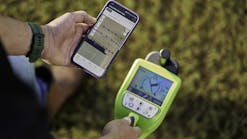Vermeer AutoTension Streamlines Bore Operations
Vermeer AutoTension is an optional feature designed to simplify the connection of two horizontal directional drills working on intersect bores. The system is available for the D220x500 S3 and D550 horizontal directional drills.
After completing a pilot bore, a drill outfitted with AutoTension allows HDDs on both sides of the bore to work together to increase the efficiency of reamer passes and the process of adding or removing drill rods to the tail string, according to the company. AutoTension maintains a steady tension force on the drill string, helping to streamline large diameter and long-distance bores.
More applications employ an HDD on each side of a large diameter or long bore, according to Marv Klein, application specialist. AutoTension allow both crews to work together while reaming and swabbing a bore hole.
“This leads to more efficient and accurate reamer passes without the need for a mechanical locking swivel or breakout tongs for rod handling,” said Klein in a statement. “Also, AutoTension helps optimize fluid management on the job because the need to transport fluids using vacs or pumps from one side to the other is reduced because crews can pull ream and pump fluids from either side.”
The AutoTension feature, engaged from the control station, maintains a desired tension on the tail string throughout the drilling process. It allows for temporary disengagement when necessary—such as during rod additions or removals—without halting operations. This flexibility extends to directional changes, enabling the driving machine to switch between pushing and pulling without requiring action from the operator in the other drill.
The AutoTension feature also includes a safety system that engages with the operator leaves the seat, locking out certain controls and sounding an audible alert.
Fleets can match different Vermeer HDDs with the D220x500 S3 or D550 using AutoTension, according to the company. Vermeer dealers can also add the feature to existing D220x500 S3 or D550 units.





